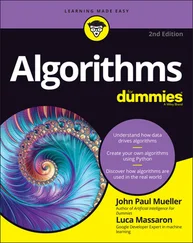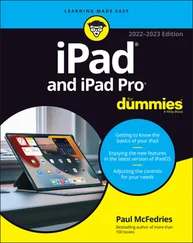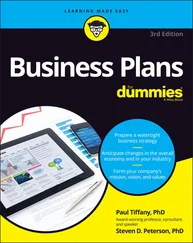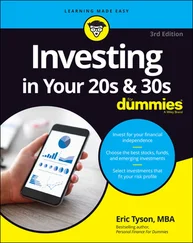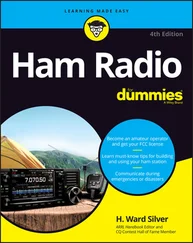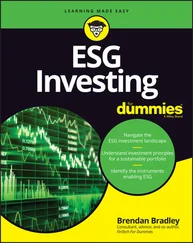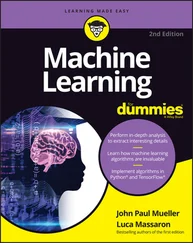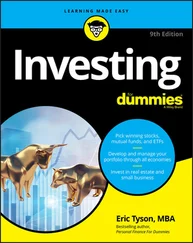1 ...7 8 9 11 12 13 ...16 Counterparty risk: Gold and silver, for example, don’t have counterparty risk, unlike most “paper assets” (such as stocks, bonds, and currencies). I cover this very important point in depth in Chapter 2.
In this chapter, you find out about types of investment risks in the world of precious metals, discover how to minimize your risk when you invest in gold and silver, and get tips on balancing risk versus return.
THE VALUE OF GOLD IN RECENT HISTORY
A good example of the value of, say, gold or silver is when we discuss inflation risk. Throughout history, when inflation raged in an economy (such as Venezuela from 2015 to 2020 or Yugoslavia during 1993–1994), gold and silver held their value while currencies were rapidly losing their value in terms of buying goods and services. Those citizens were able to trade using gold and silver to exchange with goods and services and get that same basket of goods and services when, in terms of the currency, the price was skyrocketing.
Take Zimbabwe during its hyperinflation in 2006–2007. A roll of toilet paper skyrocketed to a price of $145,750. Meanwhile, that same roll of toilet paper was selling for $0.69 in the U.S., and a single ounce of gold could have literally bought a truckload of toilet paper (I guess that gives an entrepreneur a great opportunity to sell toilet paper at a nice profit in Zimbabwe).
In the 1950s, you could have bought a nice man’s wool suit for about $30. However, that same equivalent suit would cost you about $1,000 in 2020. In that case, an ounce of gold in each case would have helped you acquire that same suit with money to spare (in case you also want to buy a pallet of toilet paper!).
At the time of writing this book, the Federal Reserve had printed nearly $10 trillion in dollars in an attempt to mitigate the financial and economic crisis stemming from the global pandemic hitting the U.S. economy in spring 2020. Given that, the risks of inflation increased, which, in turn, give gold and stock investors another reason to add those shiny metals to their portfolio.
Exploring Different Kinds of Risks
Before I make you paranoid about risk, keep in mind that it’s ubiquitous and just a normal part not only in building wealth but also in living life. Heck, just getting out of bed in the morning could pose a problem. Here are the various types of risks you face when you invest in gold and silver (now that you’re out of bed).
By physical risks, I don’t mean that you may hurt your back from picking up precious metals (heavy metal is a different animal altogether). It just means that if you have gold in physical form, you have to understand that having it has risks, as does owning any valuable property. You have to keep it in safekeeping. For some, that means keeping your physical metals (such as gold, silver, and platinum) possessions in a safe-deposit box at the bank. For others, it means keeping them in a secure hiding place at home. For still others, it means getting storage with vendors such as bullion dealers.
You have to decide. Gold as a physical holding means you have to be concerned about the risk of loss or theft. Then there’s the relative risk — what if your relative finds out? Removing some risk always means common sense. After all, if gold hits $3,000 an ounce, I don’t think you should be boasting about your investing skills at the local bar.
 Market risks may be the most prevalent risks associated with gold. What is market risk? It’s the fact that whenever you buy an asset (physical, common stock, and so on), its price is subject to the ups and downs of the marketplace. In gold, as in many investments, the price can fluctuate and can do so very significantly. What if you buy today, but tomorrow there are more sellers than buyers in the gold market? Then obviously, the price of gold would go down. The essence of market risk in commodities such as precious metals is supply and demand.
Market risks may be the most prevalent risks associated with gold. What is market risk? It’s the fact that whenever you buy an asset (physical, common stock, and so on), its price is subject to the ups and downs of the marketplace. In gold, as in many investments, the price can fluctuate and can do so very significantly. What if you buy today, but tomorrow there are more sellers than buyers in the gold market? Then obviously, the price of gold would go down. The essence of market risk in commodities such as precious metals is supply and demand.
Another element of market risk can occur when you’re involved in a “thinly traded market.” In other words, there may not be that many buyers and sellers involved. This is also called liquidity risk. This can happen, for example, in futures (covered in Chapter 12). Although futures are usually a liquid market (an adequate pool of buyers and sellers), there may be some aspects of it when it may not be that liquid. Say that you want to sell a futures contract that you recently bought that isn’t an actively traded contract. What if there are no buyers when you want to sell? Your order to sell through the broker may sit there for a long time. The sale price of the contract would drop, and you would lose some gain or even end up with a loss. Be sure to communicate with the broker regarding how active that particular market is.
Another example is the market risk of mining stocks. The stock of mining companies certainly can go up and down like most any other publicly traded stock. Stock investors can sell stock when they see or expect problems with the company. If, for example, you’re considering a gold mining company, the risk to consider is more than just the fact that it’s gold and the commensurate market risks with gold itself. It’s also about the company. Is management doing a good job? Is the company profitable? Are sales increasing? How about their earnings? Do they have too much debt? And so on. Mining stocks are covered in Chapter 7.
What the heck is exchange risk? That sounds odd! Well, it’s not a reference to currency exchange; it’s a reference to the risks that could occur at the exchanges where futures and options are traded. When futures (see Chapter 12) and options (see Chapter 13) are transacted at an exchange, such as at the Chicago Board of Trade (CBOT) or the New York Mercantile Exchange (NYMEX), they are done so under the rules and regulations of the exchange. The exchange can either purposely or accidentally encourage market outcomes by changing the rules and regulations on an ongoing basis.
A real-life example happened in the spring of 2011 with silver futures at the NYMEX. Silver rallied to $49.85 (pennies away from matching its all-time high), and the exchange, in an effort to dampen what seemed like frenzied buying, aggressively raised the margin requirements on silver futures contracts to try to quell overspeculation. When normally you could put down 10 percent to speculate on a futures contract, the new amount would be raised to, say, 12 or 15 percent or possibly more. When you require people to put more funds in for the ability to speculate, then of course you’ll diminish that activity. If the margin requirements are raised too high, that will result in more selling. More selling results in prices dropping.
 The exchanges want an orderly market, and they may change regulations or adjust requirements to encourage or exact an outcome. Sometimes that outcome may result either purposely or accidentally in a negative way for you. Here are the several events that may happen at an exchange:
The exchanges want an orderly market, and they may change regulations or adjust requirements to encourage or exact an outcome. Sometimes that outcome may result either purposely or accidentally in a negative way for you. Here are the several events that may happen at an exchange:
Margin requirements may change. I give an example earlier in this section, and this is the most common event that an exchange could enact.
“Liquidation only” can happen. Although rare, this means that the exchange may temporarily restrict the buying side, and only selling can occur, thus forcing the price down. This occurred with silver in 1980 when it hit its then all-time high of $50.
Читать дальше
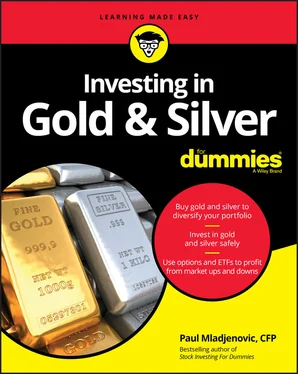
 Market risks may be the most prevalent risks associated with gold. What is market risk? It’s the fact that whenever you buy an asset (physical, common stock, and so on), its price is subject to the ups and downs of the marketplace. In gold, as in many investments, the price can fluctuate and can do so very significantly. What if you buy today, but tomorrow there are more sellers than buyers in the gold market? Then obviously, the price of gold would go down. The essence of market risk in commodities such as precious metals is supply and demand.
Market risks may be the most prevalent risks associated with gold. What is market risk? It’s the fact that whenever you buy an asset (physical, common stock, and so on), its price is subject to the ups and downs of the marketplace. In gold, as in many investments, the price can fluctuate and can do so very significantly. What if you buy today, but tomorrow there are more sellers than buyers in the gold market? Then obviously, the price of gold would go down. The essence of market risk in commodities such as precious metals is supply and demand. The exchanges want an orderly market, and they may change regulations or adjust requirements to encourage or exact an outcome. Sometimes that outcome may result either purposely or accidentally in a negative way for you. Here are the several events that may happen at an exchange:
The exchanges want an orderly market, and they may change regulations or adjust requirements to encourage or exact an outcome. Sometimes that outcome may result either purposely or accidentally in a negative way for you. Here are the several events that may happen at an exchange:

